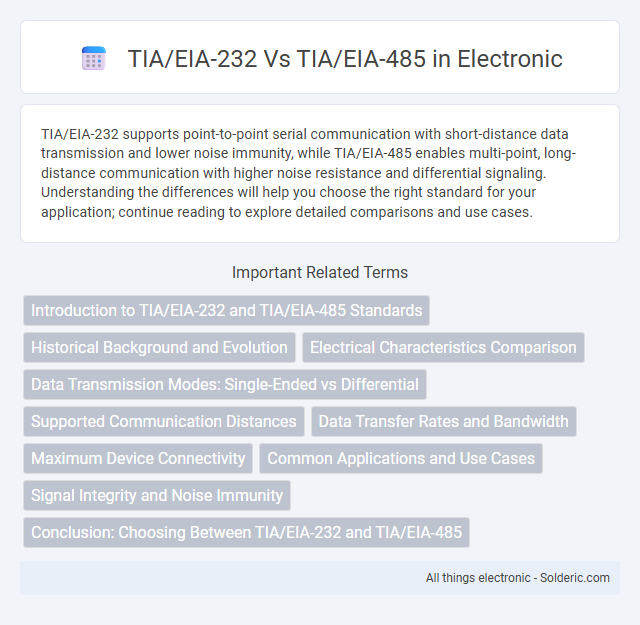TIA/EIA-232 supports point-to-point serial communication with short-distance data transmission and lower noise immunity, while TIA/EIA-485 enables multi-point, long-distance communication with higher noise resistance and differential signaling. Understanding the differences will help you choose the right standard for your application; continue reading to explore detailed comparisons and use cases.
Comparison Table
| Feature | TIA/EIA-232 | TIA/EIA-485 |
|---|---|---|
| Standard Type | Single-ended serial communication | Differential serial communication |
| Signal Lines | One transmit, one receive, ground | Balanced twisted pair, differential signals |
| Max Distance | Up to 15 meters (50 feet) | Up to 1200 meters (4000 feet) |
| Max Devices on Bus | 1 transmitter, 1 receiver | Up to 32 transceivers |
| Data Rate | Up to 20 kbps | Up to 10 Mbps (short distances) |
| Noise Immunity | Low, susceptible to noise | High, good noise immunity |
| Connector | DB9 or DB25 | Typically terminal blocks or RJ45 |
| Use Cases | Point-to-point communication, legacy systems | Multi-drop industrial networks, long distances |
Introduction to TIA/EIA-232 and TIA/EIA-485 Standards
TIA/EIA-232 is a standard defining serial communication transmission of data between data terminal equipment and data communication equipment, primarily supporting point-to-point, single-ended signaling over short distances up to 50 feet at speeds up to 20 kbps. TIA/EIA-485, also known as RS-485, specifies differential signaling for multi-point communication allowing up to 32 devices on a bus over distances up to 4,000 feet, supporting higher data rates and improved noise immunity. These standards are fundamental in industrial and commercial communication systems, with TIA/EIA-232 being common for legacy serial interfaces and TIA/EIA-485 preferred for robust, long-distance, and multi-drop network applications.
Historical Background and Evolution
TIA/EIA-232, introduced in the 1960s, established the standard for serial communication between data terminal equipment and data communication equipment, primarily for short-distance, point-to-point connections. In response to the growing need for longer cable lengths and multi-drop networks, TIA/EIA-485 emerged in the 1980s, enabling differential signaling for improved noise immunity and allowing up to 32 devices on a single bus. Your choice between these protocols depends on the required communication distance, network topology, and noise environment.
Electrical Characteristics Comparison
TIA/EIA-232 features single-ended signaling with voltage levels typically ranging from +-3 to +-15 volts, supporting short-distance communication up to 50 feet. In contrast, TIA/EIA-485 uses differential signaling with voltages between -7 and +12 volts, allowing for noise-resistant transmission over longer distances up to 4,000 feet and multiple device connections. Your choice between these standards depends on the required communication distance and noise immunity for your application.
Data Transmission Modes: Single-Ended vs Differential
TIA/EIA-232 uses single-ended data transmission, which relies on one wire per signal and a common ground, making it more susceptible to noise and limited to shorter distances of up to 50 feet. TIA/EIA-485 employs differential transmission, using pair wires for each signal that carry opposite voltages, enhancing noise immunity and supporting longer distances up to 4,000 feet. Your choice between these standards impacts data integrity and communication range based on the transmission mode used.
Supported Communication Distances
TIA/EIA-232 supports communication distances up to 50 feet (15 meters), making it suitable for short-range serial communication in devices like computers and modems. In contrast, TIA/EIA-485 enables much longer communication distances, often reaching up to 4,000 feet (1,200 meters), ideal for industrial environments that require robust and reliable data transmission over extended spans. Choosing between these standards depends on your specific application's distance requirements and noise immunity needs.
Data Transfer Rates and Bandwidth
TIA/EIA-232 supports data transfer rates typically up to 20 kbps and is suitable for short-distance, low-bandwidth applications. TIA/EIA-485 offers significantly higher data transfer speeds, reaching up to 10 Mbps, and supports longer cable lengths with improved noise immunity. Choosing TIA/EIA-485 can enhance Your system's bandwidth and communication efficiency in industrial environments.
Maximum Device Connectivity
TIA/EIA-232 supports point-to-point connections typically limited to one transmitter and one receiver, restricting device connectivity to just two devices. TIA/EIA-485 enables multidrop communication, allowing up to 32 devices on a single bus, significantly expanding maximum device connectivity for industrial and networked environments. Your choice between these standards affects scalability and network complexity based on the number of devices required in the system.
Common Applications and Use Cases
TIA/EIA-232 is commonly used for serial communication in computer serial ports, modem connections, and peripheral devices, supporting short-distance data transfer typically under 15 meters. TIA/EIA-485 excels in industrial environments, enabling robust multi-point communication over long distances up to 1200 meters, ideal for automation systems, building management, and motor control networks. The differential signaling in TIA/EIA-485 enhances noise immunity, making it suitable for electrically noisy environments where multiple devices share the same bus.
Signal Integrity and Noise Immunity
TIA/EIA-232, designed for short-distance serial communication, uses single-ended signaling, making it more susceptible to noise and signal degradation over longer cable lengths. In contrast, TIA/EIA-485 employs differential signaling, enhancing signal integrity and providing superior noise immunity by canceling out common-mode interference. This differential approach allows TIA/EIA-485 to maintain reliable data transmission in electrically noisy industrial environments and over extended distances.
Conclusion: Choosing Between TIA/EIA-232 and TIA/EIA-485
TIA/EIA-232, designed for short-distance, point-to-point communication with lower data rates, is ideal for simple serial connections within a single device or close equipment. TIA/EIA-485 supports multi-drop configurations, longer cable lengths up to 1200 meters, and higher noise immunity, making it suitable for industrial environments and networked devices. Selecting between TIA/EIA-232 and TIA/EIA-485 depends on distance, number of devices, and environmental noise, with RS-485 preferred for complex, long-distance, or multi-node setups.
TIA/EIA-232 vs TIA/EIA-485 Infographic

 solderic.com
solderic.com